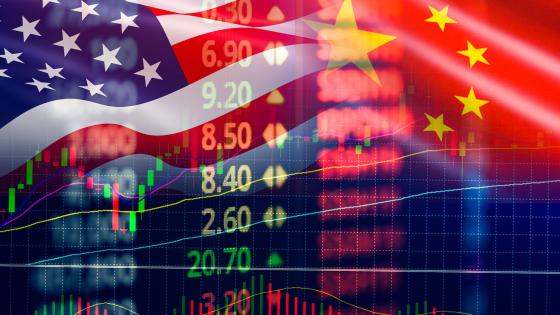Continuing Trade Tensions: Trump's 30% Tariffs On China Extended

Table of Contents
The Initial Imposition of Tariffs and their Rationale
The initial imposition of 30% tariffs on a wide range of Chinese goods began during the Trump administration. The stated rationale behind these punitive measures centered on addressing what the administration deemed unfair trade practices by China. These included:
- Significant Trade Imbalance: A persistent and substantial trade deficit between the US and China.
- Intellectual Property Theft: Allegations of widespread theft of intellectual property from American companies operating in China.
- Unfair Trade Practices: Claims of various unfair trade practices, including subsidies to Chinese companies and forced technology transfer.
Key players involved in this trade dispute included President Trump, then-US Trade Representative Robert Lighthizer, and various Chinese government officials, including Vice Premier Liu He. The tariffs initially targeted a broad spectrum of goods, significantly impacting several key sectors:
- Electronics: A wide variety of consumer electronics and components.
- Textiles and Apparel: Clothing, footwear, and related products.
- Machinery and Equipment: Industrial machinery and various types of equipment.
- Steel and Aluminum: Contributing to broader concerns about global metal markets.
Economic Impact of the Extended Tariffs
The extended 30% tariffs imposed by the Trump administration have had a multifaceted and far-reaching economic impact, affecting both the US and China, as well as global supply chains.
Impact on the US: While proponents argued that the tariffs would protect American industries and jobs, critics pointed to increased prices for consumers and disruptions to businesses reliant on Chinese imports. Data suggests:
- Increased prices for various consumer goods, contributing to inflation.
- Potential job losses in some sectors dependent on imports from China.
- Disruptions to US supply chains, forcing businesses to seek alternative sourcing.
Impact on China: The tariffs significantly impacted Chinese exports to the US, leading to:
- Reduced economic growth in certain sectors.
- Increased pressure on Chinese businesses to find alternative markets.
- Potential job losses in export-oriented industries.
These economic sanctions have contributed to heightened global trade tensions and uncertainty, impacting the broader landscape of global trade and US-China trade relations. The trade war has significantly influenced economic sanctions and global trade patterns.
Political Implications and International Response
The political ramifications of Trump's 30% tariffs on China have been significant, both domestically and internationally. Within the US, the tariffs became a highly divisive political issue, with supporters arguing for their protectionist benefits and opponents highlighting the economic costs.
Internationally, the tariffs triggered a range of responses:
- WTO Challenges: China and other countries challenged the tariffs through the World Trade Organization (WTO), arguing against their compatibility with international trade rules.
- Retaliatory Tariffs: China imposed retaliatory tariffs on US goods, escalating the trade war.
- Concerns from Allies: US allies expressed concerns about the potential negative impact of the tariffs on global trade and the multilateral trading system.
The geopolitical implications are substantial, impacting trade negotiations and US-China diplomatic relations. These actions have significantly impacted international trade and highlighted the complexity of trade relations in the modern era.
Future Outlook and Potential Solutions
The long-term effects of Trump's 30% tariffs on China remain uncertain. Several potential scenarios could unfold:
- De-escalation through Negotiation: A negotiated settlement could lead to a gradual reduction of tariffs and a more stable trade relationship.
- Continued Trade Tensions: The tariffs could remain in place, leading to continued trade tensions and economic uncertainty.
- Structural Changes: The trade war might prompt structural changes in global supply chains, with companies diversifying their sourcing beyond China.
Potential solutions for de-escalation include:
- Bilateral Trade Negotiations: Renewed efforts to reach a comprehensive trade agreement.
- Tariff Reduction: A phased reduction of tariffs on both sides.
- Enhanced Economic Cooperation: Increased cooperation on issues such as intellectual property protection and market access.
Conclusion: The Lingering Shadow of Trump's 30% Tariffs on China
Trump's 30% tariffs on China have had a profound and lasting impact on global trade, significantly affecting economic activity and international relations. The economic consequences, ranging from increased consumer prices to supply chain disruptions, continue to reverberate. The political fallout has strained US-China diplomatic ties and raised questions about the future of multilateral trade agreements. The long-term effects remain uncertain, highlighting the need for continued engagement and effective strategies for de-escalation and conflict resolution. Stay informed about ongoing developments in US-China trade relations and the impact of Trump's 30% tariffs on China, tariff policies, and related trade negotiations through further research and engagement.

Featured Posts
-
 Dyr Sydt Allwyzt Ystdyf Qdas Alqyamt Tqryr Alwkalt Alwtnyt Llielam
May 19, 2025
Dyr Sydt Allwyzt Ystdyf Qdas Alqyamt Tqryr Alwkalt Alwtnyt Llielam
May 19, 2025 -
 Legendary Singer Johnny Mathis Retiring From The Stage
May 19, 2025
Legendary Singer Johnny Mathis Retiring From The Stage
May 19, 2025 -
 The Phillies Triple A Slugger Promotion Time
May 19, 2025
The Phillies Triple A Slugger Promotion Time
May 19, 2025 -
 Real Madrids Ambitious Transfer Plans After Mbappes Arsenal Disappointment
May 19, 2025
Real Madrids Ambitious Transfer Plans After Mbappes Arsenal Disappointment
May 19, 2025 -
 Mairon Santos Lightweight Move A Post Yusuff Fight Analysis
May 19, 2025
Mairon Santos Lightweight Move A Post Yusuff Fight Analysis
May 19, 2025
